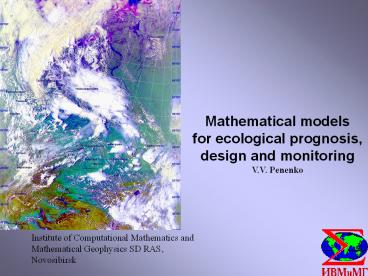Institute of Computational Mathematics and PowerPoint PPT Presentation
1 / 35
Title: Institute of Computational Mathematics and
1
Mathematical models for ecological prognosis,
design and monitoring V.V. Penenko
Institute of Computational Mathematics and
Mathematical Geophysics SD RAS, Novosibirsk
2
What is the role of atmospheric chemistry in
amplifying or damping climate change?
How will human activities transform the
dynamical and chemical properties of the future
atmosphere?
How will quality of life change?
3
System organization of environmental modeling
- Models of processes
- hydrodynamics
- transport and transformation
- of pollutants
Data bases Models of observations
Functionals
Quality, observations, restrictions, control,
cost,etc.
extended functional model as integral identity
Solution of forward problems
Solution of adjoint problems
Calculation of sensitivity functions and
variations of functionals
Identification of parameters, decrease of
uncertainties, data assimilation, monitoring
Analysis of sensitivity relations risk/vulnerabili
ty, observability, sources
System of decision making, design
4
Approaches and tools
- Analysis of the climatic system for construction
- of long-term scenarios
- Extraction of multi- dimentional and
- multi-component factors from data bases
- Classification of typical situations with
respect - to main factors
- Investigation of variability
- Formation of leading spaces
5
Scenario approach
Models of hydrodynamics Models of transport and
transformation of pollutants (gases and
aerosols) Sensitivity and observability
algorithms Combination of forward and inverse
techniques Joint use of models and data Nested
models and domains
6
(No Transcript)
7
Model of hydrodynamics
8
(No Transcript)
9
Transformation of moisture and pollutants
Gases and aerosols
- interaction with underlying surface
- dry and wet deposition
- condensation and evaporation
- coagulation
- Model of atmospheric chemistry
- Model of aerosol dynamics
- Model of moisture transformation
- water vapour
- cloud water
- rain water
10
is the function of pressure
11
Model of aerosol dynamics
-concentration of particles in volume
- coagulation kernel
- rates of condensation and evaporation
- coefficients of diffusive change of particles
- removal parameter
-source term
-parameters of collective interaction of particles
12
Hydrological cycle of atmospheric circulation
for studying aerosols
Notations
- content of water vapor, cloud water and rain
water in respectively
- autoconversion of cloud water to rain water
(dt)
- accretion of cloud droplets by rain drops (dt)
- evaporation of rain water(dt)
- condensation (evaporation)(dt)
If supersaturation --gtcondensation
13
Hydrological cycle
input
no
no
yes
yes
no
no
yes
yes
no
yes
yes
yes
output
14
(No Transcript)
15
Functionals of measurements
16
The structure of the source term
source power
source shape
reference point of the source
Particular case
17
Functionals for assessment of source parameters
18
(No Transcript)
19
(No Transcript)
20
(No Transcript)
21
The main sensitivity relations
The algorithm for calculation of
sensitivity functions
The feed-back relations
are the sensitivity functions
are the parameter variations
22
23
Factor analysis ( global scale). Reanalysis
1960-1999
hgt 500, june
24
West Siberia region
60-105 E, 45-65 N
June, 1960-1999
25
Eigenfunction N1, June, 1960-1999
Global, 17
West Siberia, 97
26
Novosibirsk
27
East Siberia Region
90-140 E, 45-65 N
June,1960-1999
28
Eigenvectors N1, June, 1960-1999
Global, 17
East Siberia, 97
29
Irkutsk
30
.
June 16 2003 ?
31
(No Transcript)
32
18.06.2003
33
Sensitivity relation for estimation of
risk/vulnerability and observability
34
Sensitivity function for estimation of
risk/vulnerability domains for Lake Baikal
35
Conclusion
- Combination of
- forward and inverse modeling
- factor and principle component analysis
- sensitivity theory
- on the base of variational principles
- gives the possibility for coordinated solution
- of the variety of environmental problems, such as
- diagnosis
- prognosis
- monitoring (mathematical background)
- design

